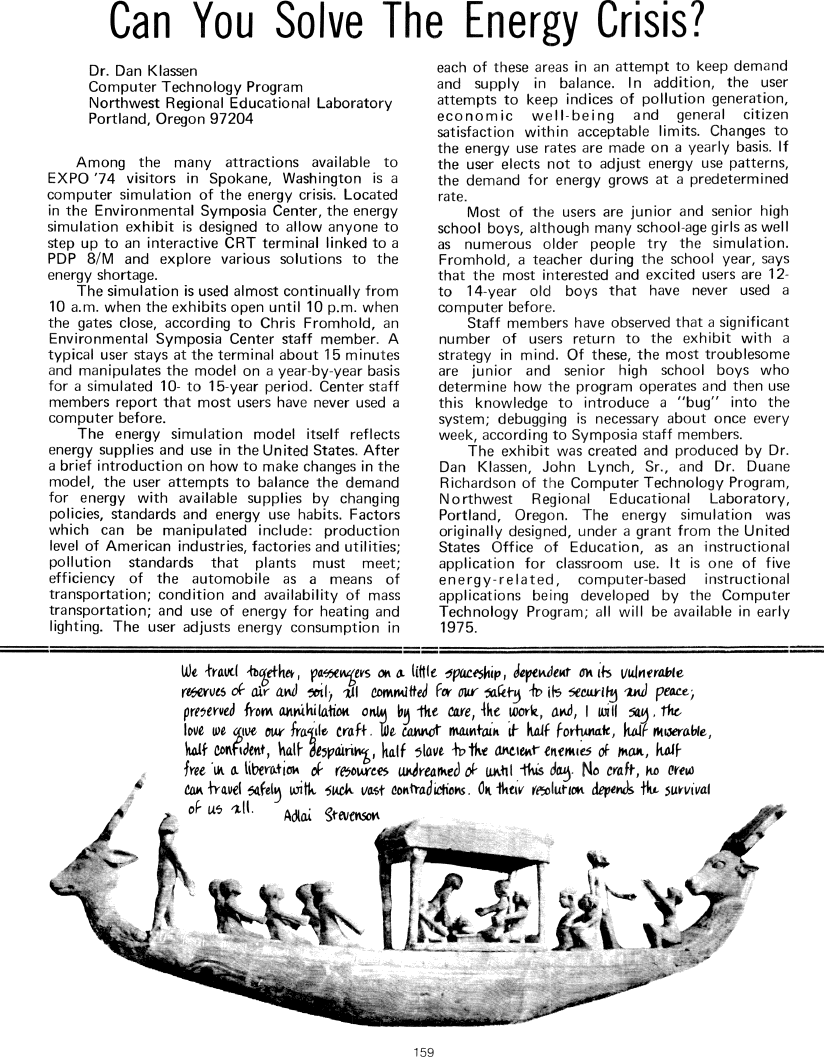The Best of Creative Computing Volume 1 (published 1976)
Can You Solve The Energy Crisis? (Computer simulation of energy crisis at EXPO '74)

Can You Solve The Energy Crisis?
Dr. Dan Klassen
Computer Technology Program
Northwest Regional Educational Laboratory
Portland, Oregon 97204
Among the many attractions available to
EXPO '74 visitors in Spokane, Washington is a
computer simulation of the energy crisis. Located
in the Environmental Symposia Center, the energy
simulation exhibit is designed to allow anyone to
step up to an interactive CRT terminal linked to a
PDP 8/M and explore various solutions to the
energy shortage.
The simulation is used almost continually from
10 a.m. when the exhibits open until 10 p.m. when
the gates close, according to Chris Fromhold, an
Environmental Symposia Center staff member. A
typical user stays at the terminal about 15 minutes
and manipulates the model on a year-by-year basis
for a simulated 10- to 15-year period. Center staff
members report that most users have never used a
computer before.
The energy simulation model itself reflects
energy supplies and use in the United States. After
a brief introduction on how to make changes in the
model, the user attempts to balance the demand
for energy with available supplies by changing
policies, standards and energy use habits. Factors
which can be manipulated include: production
level of American industries, factories and utilities;
pollution standards that plants must meet;
efficiency of the automobile as a means of
transportation; condition and availability of mass
transportation; and use of energy for heating and
lighting. The user adjusts energy consumption in
each of these areas in an attempt to keep demand
and supply in balance. In addition, the user
attempts to keep indices of pollution generation,
economic well-being and general citizen
satisfaction within acceptable limits. Changes to
the energy use rates are made on a yearly basis. If
the user elects not to adjust energy use patterns,
the demand for energy grows at a predetermined
rate.
Most of the users are junior and senior high
school boys, although many school-age girls as well
as numerous older people try the simulation.
Fromhold, a teacher during the school year, says
that the most interested and excited users are 12-to
14-year old boys that have never used a
computer before.
Staff members have observed that a significant
number of users return to the exhibit with a
strategy in mind. Of these, the most troublesome
are junior and senior high school boys who
determine how the program operates and then use
this knowledge to introduce a "bug" into the
system; debugging is necessary about once every
week, according to Symposia staff members.
The exhibit was created and produced by Dr.
Dan Klassen, John Lynch, Sr., and Dr. Duane
Richardson of the Computer Technology Program,
Northwest Regional Educational Laboratory,
Portland, Oregon. The energy simulation was
originally designed, under a grant from the United
States Office of Education, as an instructional
application for classroom use. It is one of five
energy-related, computer-based instructional
applications being developed by the Computer
Technology Program; all will be available in early
1975.
___________________________________________________________________
___________________________________________________________________
***
we travel together, passengers on a little spaceship, dependent on its
vulnerable
reserves of alr and soil; all committed For our safety to its security and
peace;
preserved from annihilation only by the care, the work, and, I will say. the
love we give our fragile craft. We cannot maintain it half fortunate, half
miserable,
half confident, half despairing, half slave to the ancient enemies of man, half
free in a liberation of resources undreamed of until this day. No craft, no crew
can travel safely with such vast contradictions. On their resolution depends the
survival
of us all.
Adlai Stevenson
[Image]


